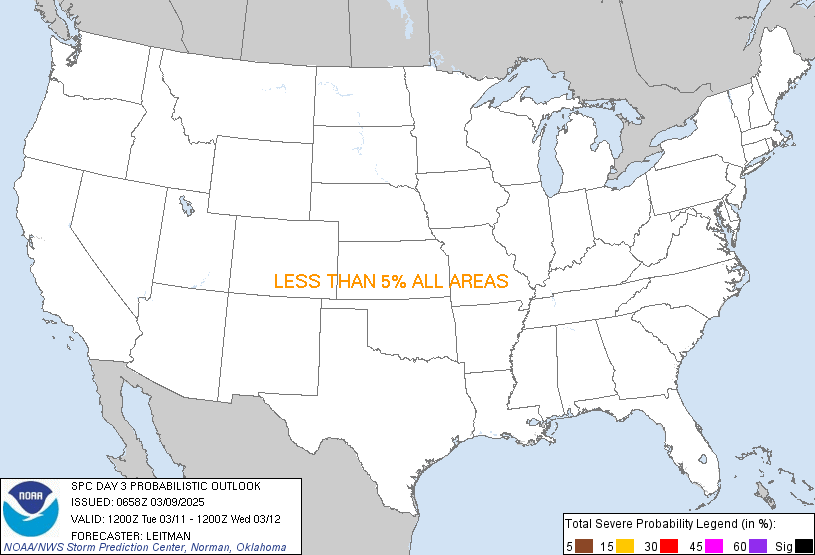This morning, the Storm Prediction Center issued its Day 3 Convective Outlook.
In increasing levels of threat, here are the five categories in a SPC Outlook (Parenthetical explanations are mine; certainly not official!):
1. Nothing.
2. General Thunderstorms. (Some lightning, nothing severe expected).
3. Slight Risk. (Risk of severe weather is real).
4. Moderate Risk. (Severe weather risk is real, spectacular, and of particular concern).
5. High Risk. (Rare, very dangerous situation).
Sunday, we’re in a Slight Risk.
Technically, the probability of any severe weather event happening within 25 miles of you is 30%:

SPC likes to say if the probability of a tornado/hail/severe wind event on a November day is 1%, a 30% probability means your risk is 30x greater than it is on an ordinary day.
Tornado? Hail? Wind? What?
All needed severe weather ingredients will be around, but in varying quantities and ETAs. As usual, we’ll have a better handle on things tomorrow and Sunday morning when those variables show themselves, making everything more predictable. If you want the SPC’s detailed/technical analysis, read this.
Three days away, it’s difficult to say what mode of severe weather exists. Current thinking:
Tornadoes? Maybe. If we get some sunshine Sunday morning, the atmosphere’s “boundary layer” (weather-speak for the ground/surface) will heat up and destabilize. With other tornado-making ingredients in place, destabilization would create a chance of a tornado if the timing is right.
Damaging Winds? Yeah, probably, especially along the late-day squall line.
Hail? SPC didn’t mention it, but that does not mean it won’t happen.
What Time?
There’s no good answer. Our NWS says thunderstorms are likely Sunday morning, then late Sunday afternoon, but there’s a chance of thunderstorms all day. That’s the best explanation I’ve read.
Keep in mind, there are two potential rain/storm opportunities:
1. Early-in-the-day storms coming out ahead of the main squall line.
Models are all over the place on this. They’re possible anytime Sunday, starting in the morning, but more likely afternoon.
2. The squall line itself.
The GFS weather model delivers the squall line here around dark. The European weather model agrees.
The NAM delays the squall line until well after dark; by 6 pm, it’s still lagging way behind (see below – notice the NAM thinks the heavier storms will be in the Ohio Valley):
Get the feeling there’s more we don’t know than we do know? Me too!
Meteorologically, we’re still too far away from “the event” to nail down ETAs, storm mode, and intensity. But we can say the ingredients are in place for severe weather, and you need to keep an eye on it this weekend.
Could this be a huge “bust” and nothing happen? Yeah, that could happen. Stay tuned.
The best bet in this whole thing is that we’ll get somewhere around a half-inch of rain Sunday.
More details coming this afternoon when the new data arrives.




 Log In To Facebook To Comment
Log In To Facebook To Comment